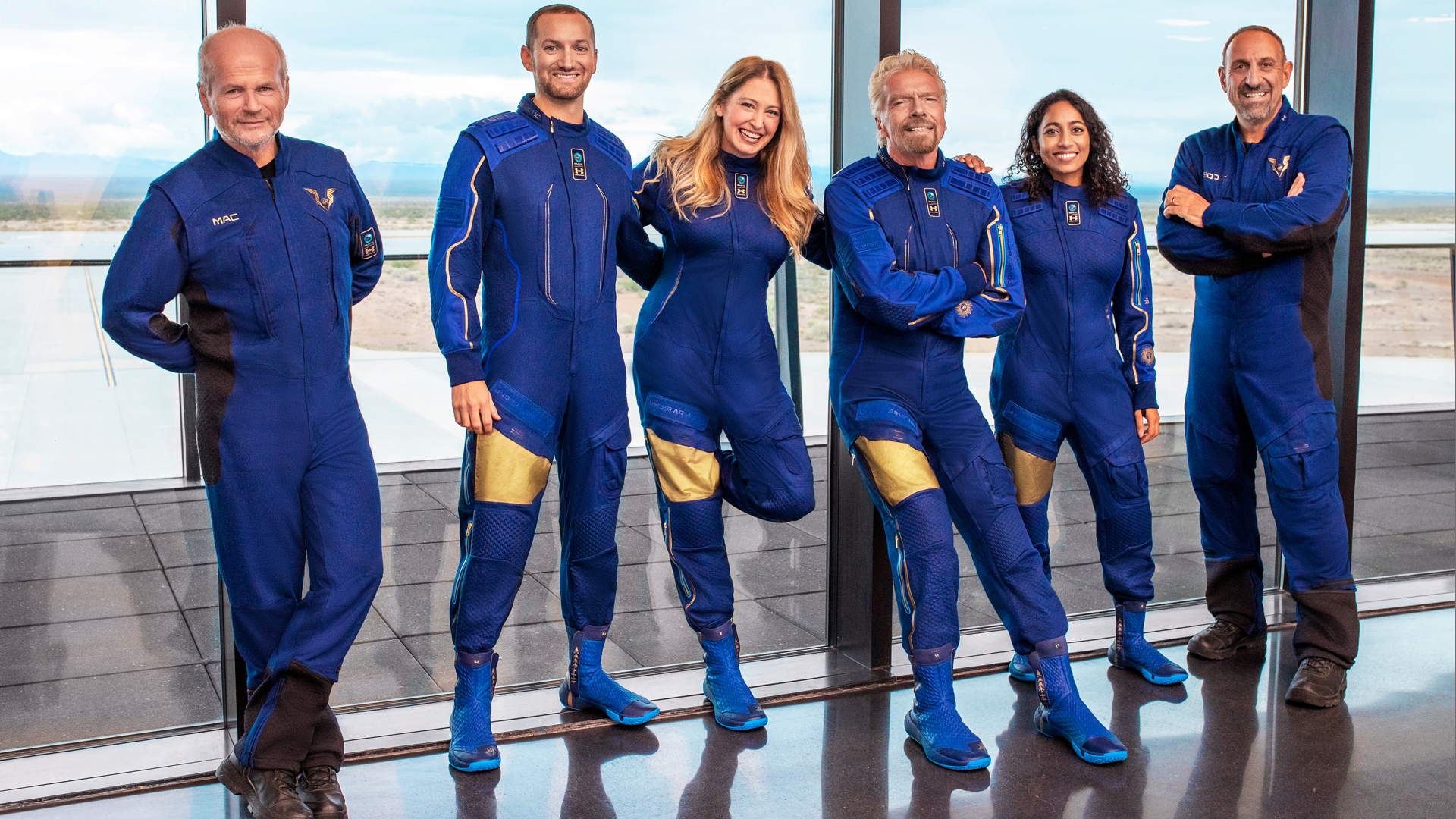Will Richard Branson actually reach space on Virgin Galactic's 1st fully crewed launch?

As the commercial race to suborbital space has heated up in the past few years, a tricky question has popped up again and again: Where does outer space begin?
This is not just a philosophical debate. It has real-world financial implications, because one space tourism company is selling seats on missions that may not reach the final frontier, depending on where you think the boundary lies.
That company is Virgin Galactic, which is set to launch Virgin Group founder Richard Branson and several other folks on a landmark test mission this Sunday (July 11) aboard the company's VSS Unity space plane. Unity has reached suborbital space three times to date, most recently during a piloted test flight on May 22 — or has it?
Related: How Virgin Galactic's SpaceShipTwo works (infographic)
Unity's three spaceflights reached maximum altitudes of 51.4 miles, 55.9 miles and 55.4 miles (82.7, 89.9 and 89.2 kilometers, respectively). That's high enough for those on board to earn their astronaut wings by the standards of NASA, the Federal Aviation Administration (FAA) and the U.S. military, which regard outer space to begin 50 miles (80 km) above Earth's surface.
But it's below another widely recognized boundary — the Kármán line, which is generally interpreted to lie at an altitude of 62 miles (100 km). And Virgin Galactic's chief competitor in the suborbital tourism market, Jeff Bezos' Blue Origin, has called attention to this fact, noting that its own New Shepard vehicle gets well above the Kármán line.
Consider the statement that Blue Origin CEO Bob Smith emailed to The New York Times, which ran it in a July 1 story about Branson's upcoming flight: "We wish him a great and safe flight, but they're not flying above the Kármán line, and it's a very different experience."
Breaking space news, the latest updates on rocket launches, skywatching events and more!
There's some backstory to that statement. Blue Origin is gearing up for its own high-profile mission this month as well — the first crewed New Shepard flight, which will carry Bezos, his brother Mark, pioneering aviator Wally Funk and the person who paid $28 million for a seat via auction. (Blue Origin has not yet identified the auction winner.)
That New Shepard mission is scheduled to launch on July 20, the 52nd anniversary of the Apollo 11 moon landing. Blue Origin announced that target date in early May, nearly two months before Virgin Galactic unveiled its Branson-launching plans. (That big reveal came July 1).
Virgin Galactic and Branson deny that they're trying to upstage Blue Origin, saying that Unity will fly on July 11 simply because it's ready to do so.
During an interview with National Public Radio (NPR) that aired Wednesday (July 7), Branson addressed Smith's Kármán line remark, pointing out that NASA and the FAA recognize the 50-mile boundary.
In addition, "the actual difference in experience is going to be almost non-existent," Branson told NPR's Leila Fadel , noting that passengers will get roughly equal amounts of weightless time on Unity and New Shepard. Virgin Galactic has promised about 4 minutes of weightlessness on its flights.
The 50-mile line has other backers as well, including Jonathan McDowell, an astrophysicist and satellite tracker based at the Harvard-Smithsonian Center for Astrophysics, who made the case for its adoption in a 2018 paper.
In the middle of the last century, Hungarian-American physicist Theodore von Kármán proposed that space begins where the forces of orbital dynamics exceed those of aerodynamics. Placing that line at 100 kilometers came more or less via "a rough order-of-magnitude argument," McDowell wrote in the 2018 study. (After all, 100 km is much closer to the mark than 10 km or 1,000 km.)
But the actual boundary, by von Kármán's original definition, lies between 70 km and 90 km (43 to 56 miles), McDowell calculated. So, 80 km (50 miles) is a good approximation of this nebulous marker, especially considering that it represents a sort of point of no return for satellites. Spacecraft whose elliptical orbits take them lower than 80 km do not survive more than one additional loop around our planet, McDowell noted, whereas craft that stay just a few kilometers higher can remain aloft for days or weeks.
McDowell's voice is influential among researchers and laypeople alike, and NASA, the FAA and the U.S. military are already on board. So are we on the way to a universal acceptance of 50 miles as the point where space begins? Or will the debate continue for years, with the two sides becoming ever more entrenched? Either way, it'll be an interesting ride.
Mike Wall is the author of "Out There" (Grand Central Publishing, 2018; illustrated by Karl Tate), a book about the search for alien life. Follow him on Twitter @michaeldwall. Follow us on Twitter @Spacedotcom or Facebook.

Michael Wall is a Senior Space Writer with Space.com and joined the team in 2010. He primarily covers exoplanets, spaceflight and military space, but has been known to dabble in the space art beat. His book about the search for alien life, "Out There," was published on Nov. 13, 2018. Before becoming a science writer, Michael worked as a herpetologist and wildlife biologist. He has a Ph.D. in evolutionary biology from the University of Sydney, Australia, a bachelor's degree from the University of Arizona, and a graduate certificate in science writing from the University of California, Santa Cruz. To find out what his latest project is, you can follow Michael on Twitter.
